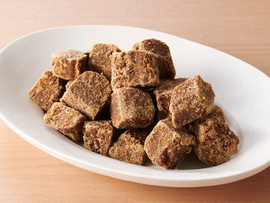
Black Sugar

KagoshimaBlack Sugar
Classification (Large)
Agricultural products
Classification (Small)
Soy sauce, miso, other seasonings
Main ingredients used
sugar cane, calcium hydroxide (or quicklime)
When using downloaded images, please read the "Terms of Use" and clearly state that the source of the image is "Traditional Foods in Japan" by the Ministry of Agriculture, Forestry and Fisheries.
If the photo credits is stated, please include it as well.
Example of description
of the photo credits
Example of description when the photo credits is not stated
Source: "Traditional Foods in Japan" Ministry of Agriculture, Forestry and Fisheries
Example of description when the photo credits is stated
Source: "Traditional Foods in Japan" Ministry of Agriculture, Forestry and Fisheries
Photo credits:xxx
Region of inheritance
Prefecture-wide, including throughout the Amami Islands and Okigahamada, Nishinoomote City, Tanegashima Island
Product overview (special characteristics and types)
Brown sugar is a processed product that is created by directly boiling down the squeezed juices of sugar cane. The sugar is rich in carbohydrates, calcium, iron, and potassium, along with vitamins and minerals, such as phosphorus and magnesium.
It has a unique flavor similar to caramel, with a deep richness and sweetness, and is commonly used in various dishes and sweets that make the most of its flavor. As brown sugar tends to solidify easily because of its moist molasses content, it is usually sold in crushed blocks, but some products are in powder form. This sugar is made in winter when sugar cane is harvested.
It is often used within the prefecture as a general sweetener, and is popular as a souvenir of the Amami Islands.
History and culture
Methods to create brown sugar were brought over from China in the Edo period (beginning of the 1600s), and it is said that manufacturing started from Amami Oshima Island.
The Amami Islands are said to have been under the rule of the Ryukyu Kingdom up to the 16th century, and came under the control of the Satsuma clan in the Edo period. In those days, brown sugar was an extremely expensive food ingredient and was used as a medicinal herb. As a result, the Satsuma clan had citizens pay their annual taxes not in rice but in brown sugar, and created an immense profit by monopolizing brown sugar as an exclusive product of the clan.
The island citizens had no choice but to focus on manufacturing brown sugar, which created a grueling situation in which production of daily food became impossible. There was also the start of post-war construction of large-scale sugar factories in Japan’s efforts to focus on sugar production. Thus, it is said that the food culture of traditional brown sugar production on the Amami Islands evolved to establish a new era.
Production method
Sugar cane is squeezed and the supernatant liquid is filtered before adding calcium hydroxide (or quicklime) to remove any harsh taste. It is then slowly boiled down in an open-hearth furnace. Once the moisture has evaporated, the sugar is cooled and hardened.
Conservation and succession efforts
In 2016, Kagoshima Prefecture established local cuisine representative of the prefecture as the [Taste of Kagoshima], and introduced 28 products (18 products found throughout Kagoshima Prefecture and 10 products from the Amami area), including brown sugar.
Furthermore, Kagoshima Prefecture established manufacturing methods and ingredient standards for foods using traditional manufacturing methods, foods that make the most of the unique qualities of the prefecture’s ingredients, and distinctive foods manufactured through unique technologies. Foods that fit these criteria are certified as [Furusato Certified Foods], and as of the end of March 2023, there are eight foods certified under brown sugar.
Main consumption method
Brown sugar can be eaten as-is or used to add flavor to various dishes and sweets. It can also be used in coffee or tea. It is commonly used in local cuisine, such as getanha, gajamame, fukuregashi, and tonkotsu. In addition, brown sugar is used as an ingredient for kuromitsu and a local specialty, brown sugar shochu liquor.
At-home recipes:Nuts coated with brown sugar

Ingredients
Brown sugar
50 g
Mixed nuts (roasted)
100 g
Water
1 tablespoon
How to make
Put brown sugar and water in a small pan and heat to a boil over medium heat.
Add walnuts and mix the ingredients well with a wooden spatula until the brown sugar is crystalized. Then, transfer the sugar-coated nuts onto a parchment sheet and let them cool.

